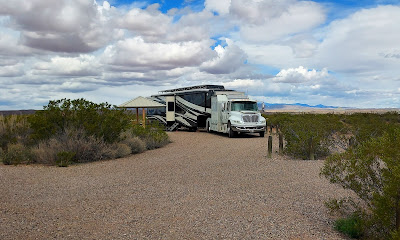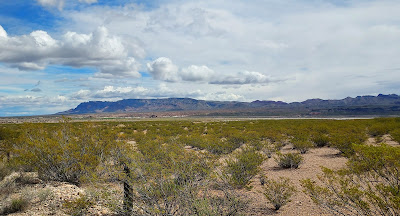We departed Organ Pipe Cactus National Monument and headed to Sonoita, AZ. I marveled at the colorful blooms that lined AZ-85: blue desert lupine, orange globemallow, and the cheerful yellow brittlebush and desert marigolds.
We stopped in Gila Bend for fuel before getting on I-8. Big mistake—we wasted 45 minutes dealing with long lines at the truck diesel lanes. Fortunately, I-8 was a pleasant drive with little interaction with other vehicles. Onto I-10, which proved to be a nightmare! Traffic was horrific due to construction zones and overall poor road conditions. It was like driving on a cheese grater! Consequently, a 4-hour trip to Bureau of Land Management’s (BLM) Las Cienegas National Conservation Area took us 6.5 hours! And Mom’s allergies kicked in big time, causing her voice to get lower and raspy. (Between you and me, this was a blessing in disguise. We could barely hear her ranting and raving about the roads while she was at the wheel!) Needless to say, we arrived later than anticipated at Sonoita, AZ on a Friday afternoon and were all tired from a stressful day of driving.
 |
| Some pretty scenery along our route. |
Las Cienegas National Conservation Area is home to the
historic Empire Ranch. Established in
the 1870s, it was once among the largest cattle ranches in all of AZ. Today, cattle still
graze on these lands. Additionally, Las
Cienegas includes a group camping area at the airstrip in Cottonwood Canyon, a non-reservable
primitive camping area called Cieneguita, plus some dispersed camping
sites. Because we visited here previously
we knew what roads on which our setup can maneuver, so we stuck to the
Cieneguita camping area, comprised of 6 huge horseshoe-shaped sites that,
according to BLM, can accommodate 2 camping units (some actually had 3 big RVs
parked on a site.)
Getting a fully unoccupied site did not look promising. Rather than venture too far down the road (we knew we would encounter a very tight turnaround), we went to the site we occupied on our last visit. Unfortunately, that site had a 25-foot travel trailer on it already. However, we reasoned that we would be parking about 100 feet away from the other unit and facing in the opposite direction. And when we occupied the site on our last visit, we graciously shared the site with another camper who arrived later in the day.
Mom had barely exited the truck before she was approached by the site occupant. Clearly, he wasn’t happy to “share” his site when Mom asked if it would be a problem. He admitted, however, we would not find any sites unoccupied. The man gave Mom the third degree: how long are you staying; are you partiers; do you make a lot of noise; where are you from. Now, with the mood Mom was in, I was worried she was going to unholster her NJ attitude (and with her laryngitis, she sounded like a full-fledged Jersey mob boss!) After all, these are free, public campgrounds and lands. There is no reservation system nor fee structure, and BLM states right on the campground info board that sites accommodate 2 rigs. But I was so proud of Mom! Though I saw her fingers twitch once or twice, Yosemite Sue transformed into Sweet Sue, and she diffused the situation with no backup from Dad. She realized quickly if she asked, “may I”, her wish to share the site would be granted. After providing acceptable answers to the occupant’s interrogation, permission to park was granted, and Mom thanked the site occupant profusely for his “generosity.” We had no further problems or awkward encounters. In fact, we only saw the occupant twice thereafter during our 3-night stay, and we were all cordial to one another.
 |
| We left plenty of room and privacy for the original site occupant--our rigs were facing in completely different directions. |
 |
| The moon rising... |
 |
| and progression of the sunset... |
 |
| Walking into Cottonwood Canyon |
 |
| ...a MAGNIFICENT sunset. |
 |
| Here's another "What if" scenario: What if I am related to "The Thing"? |
 |
| "Mystery of the Desert" - AKA "The Thing" |
We returned to the road for our destination of Elephant Butte Lake State Park, located in Truth or Consequences, NM. It is New Mexico’s largest State Park, stretching 40 miles and creating 200+miles of shoreline. This was an easy drive—until we hit some nasty rain, sleet, and chilly temps and an I-25 North ramp closure outside of Hatch, NM that detoured us about 16 miles.
There
are various campgrounds within Elephant Butte Lake State Park, but we reserved
a site in South Monticello Campground.
The Campground is a mere 8 miles off I-25 via Rock Canyon Road, but it
is hidden so stealthily in the valley that that you would never know it was
there. Though Rock Canyon Road is built
to accommodate two-way traffic, Mom sure was glad we didn’t encounter any other
vehicles on the tight curves.
South Monticello Campground is a gem with huge sites,
including many pull-throughs. There are back-in sites with waterfront views of the
reservoir, which was created by the damming of the Rio Grande River. And what a bargain at $18/day with water and
electric hook-ups and an easily-accessible dump station right as you enter the
campground. Even though the campground
is all one-way traffic, the roads are double-wide, making it a piece of cake
for big rigs to maneuver.
It was extremely windy, cloudy, and downright chilly during most of our 3-day visit. So, it was nice to have the electric hookup so we could enjoy the warmth and ambiance of our fireplace (something we could not enjoy during our 3 prior months of boondocking since the fireplace is a major energy hog).
Weather be damned, we hiked 5-6 miles each day along West Lake Shore Trail. This is an 11+ mile, well-maintained, well-marked
out-and-back trail that runs from one end of Elephant Butte Lake State Park to
another. We enjoyed serenity and
solitude, encountering only 3 other people during all of our hikes. I was happy that we logged several geocaches
along the trail, too, including one at 3 Sisters Point.
We also hiked down to what was once a dock, but dramatically-diminished water levels preclude its use now. Eureka! I found yet another geocache!
We departed Elephant Butte State Park for a 1-night stay at Escapees Dreamcatcher RV Park in Deming, NM. We utilized the last of our complimentary stay certificates that we earned in 2018 while volunteering/workcamping for 3 months at Escapees Rainbow’s End RV Park in Livingston, TX. (Work-camping opportunities are available for Escapees singles and couples. 20 hour total commitment in exchange for complimentary RV site, electric reimbursement, and complimentary stay certificates. For specific info, contact Cindy Neilsen at parks@escapees.com).
After set-up and lunch, Mom prepared the table for me and my rat pack to do Easter egg coloring. All was going well. We pulled the first 6 eggs out of the dye,
and placed the next 6 in. Then Mom made
a fatal error—she left me under Dad’s “supervision" for 5 minutes when she
ran to the RV Park office to get quarters for laundry.
When she returned, she found me stripped down to my birthday suit, my
shorts converted in color from white to pink, and Dad trying to clean up the
spill evidence. At least my parents were
able to get the stains off of me. I
wouldn’t want my adorableness ruined by having multi-colored fur!
 |
| All was going well--before the spill. |
Well, time for me to sign off. I've got to get my clothes back on! I’ll talk to you again soon!



























































